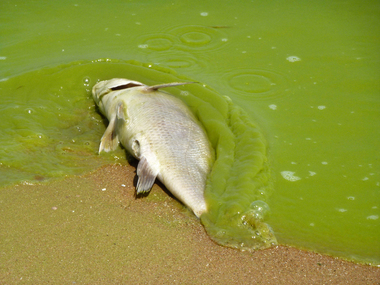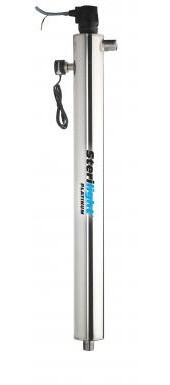In this mid- June Occasional, you’ll hear about bacteria, slime, protozoa, blue green algae, scum collecting devices, and gross gelatinous coatings. Learn how trickling filters work, how a broom is like a water filter, how fish react to drugs, and how sequestration is making hikers thirsty. An "absolutely heinous" plague of filter flies in Bryan, Texas, the sinking of a Yellow Duckmarine in Liverpool, a sports bar tragedy in Miami, and the greening of Lake Erie. Also you'll hear of NSF/ANSI standards for UV equipment, the effectiveness of silver as a biocide, the demise of the Red River Compact, unfair water rates in Melbourne, a $170,000 broom, the ongoing triumphs of Birmingham's celebrated pipe tapping team, and, as always, there is much, much more.
If you would like to read this issue on the Pure Water Gazette’s website, please go here.
While you were doing whatever you do on Father's Day, a lot of interesting things happened in the ever-changing world of water. Read on to hear about some of them.
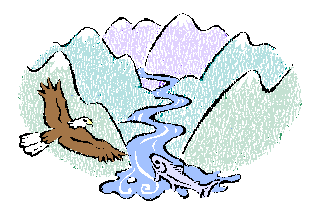
Why You Might Not Want To Live Next Door To A Wastewater Treatment Plant
"It's been absolutely heinous. These flies are invading my space and it makes me feel gross." --Bryan, Texas Resident Shannon Wolfert.
The story that we're excerpting below concerns the invasion of a neighborhood in Bryan, Texas by dreaded filter flies, aka drain flies, sewer flies, moth flies. Filter flies, as you might guess, are called filter flies because they love to congregate around water filters. Not the water filter under your sink, but a specific type filter used in wastewater treatment that is called a "trickling filter." Here's a good explanation of a trickling filter and how it works. ![]()
A trickling filter consists of a bed of highly permeable media on whose surface a mixed population of microorganisms is developed as a slime layer. The word "filter" in this case is not correctly used for there is no straining or filtering action involved. Passage of wastewater through the filter causes the development of a gelatinous coating of bacteria, protozoa and other organisms on the media. With time, the thickness of the slime layer increases preventing oxygen from penetrating the full depth of the slime layer. In the absence of oxygen, anaerobic decomposition becomes active near the surface of the media. The continual increase in the thickness of the slime layer, the production of anaerobic end products next to the media surface, and the maintenance of a hydraulic load to the filter, eventually causes sloughing of the slime layer to start to form. This cycle is continuously repeated throughout the operation of a trickling filter. For economy and to prevent clogging of the distribution nozzles, trickling filters should be preceded by primary sedimentation tanks equipped with scum collecting devices.
Primary treatment ahead of trickling filters makes available the full capacity of the trickling filter for use in the conversion of non-settleable, colloidal and dissolved solids to living microscopic organisms and stable organic matter temporarily attached to the filter medium and to inorganic matter temporarily attached to the filter medium and to inorganic matter carried off with the effluent. The attached material intermittently sloughs off and is carried away in the filter effluent. For this reason, trickling filters should be followed by secondary sedimentation tanks to remove these sloughed solids and to produce a relatively clear effluent.
It is easy to see how flies might develop a liking for a trickling filter, and the fact is that filter flies sometimes become such a nuisance that the filter has to be shut down to get rid of them. Control of filter flies other than by turning off the filter is difficult because many traditional remedies don't work well. If chlorine is used to kill off the flies, for example, it also kills off the bacteria that make the filter work. When a trickling filter is shut down, unfortunately, the filter flies don't vanish. They just move. The piece below describes what happened when a trickling filter was shut down at the Bryan, Texas wastewater treatment plant. -- Hardly Waite.
If you want to read the full article about filter flies and see a picture of a trickling filter (as I'm sure you do), you'll need to go to the Pure Water Gazette's website.
Street Cleaning Machines Are Essential Tools for Maintaining Clean Water
We usually think of street sweepers as big noisy machines that stir up dust and pick up some dirt, leaving the street looking a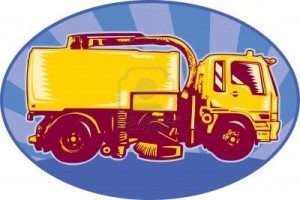 little nicer. What we don't consider is that street sweepers are an essential part of water treatment.
little nicer. What we don't consider is that street sweepers are an essential part of water treatment.
What we call ‘street dirt’ is composed of heavy metals and other pollutants—items that may be killing fish when they get into waterways via stormwater runoff. Cities use media filters to clean stormwater, but it is estimated that effective street cleaning can greatly lessen the cost of filtering. Cleaning the street as compared with filtering costs about one-forth as much, in fact.
Heavy metals like cadmium, copper, lead, zinc are specific pollutants that are found in abundance in "street dirt." In 1972, in the first USEPA publication ever on stormwater, street dirt was named as "the primary source of contamination, in terms of mass."
Much of the toxic debris that washes to storm drains from the street is from automobiles. Brake pads, for example, especially cheap brake pads, deposit large amounts of copper into the streets. This copper ends up in the water supply unless it is caught in a filter or, more economically, swept up by a street cleaning machine.![]()
Street sweeping machines vary in sophistication. Early models, which go back centuries, were used for picking up horse manure before the advent of the automobile. In the early 20th century, many US cities used them, but they were of limited effectiveness.
Mechanical machines, which use a main broom and conveyor belt to pick up material, have been around at least 100 years. Their basic design hasn’t changed that much, although impressive improvements have been made, such as the broom design and speed, and the conveyor belt speed and alignment. The mechanical machines are still the most popular, and perhaps 90% of the sweeping machines in operation are of the mechanical broom design.
Newer designs include "regenerative air" units which in one motion blow air down on the pavement to dislodge debris then immediately vacuum the dirt into a hopper. These are sometimes unpopular because unless they include air filters they stir up lots of dust. Vacuum machines can be very effective.
Even more advanced designs use water. One machine features "rotary arms with nozzles on the end that blow water down on the pavement; the back end of the machine features a powerful vacuum and a squeegee that sucks up the water and the debris it contains."
The "state of the art" machine called the Schwarze A7000 costs in the neighborhood of $170,000.
The effectiveness of the machine, of course, is determined by how much dirt it actually picks up. Ineffective machines simply move some of the dirt to a different location. The worst street cleaner of all time, of course, as well as probably the stupidest machine ever devised, is the common leaf blower, which does not remove dirt but simply moves it to a less visible spot.
Water News Highlights That You May Have Missed This Week
Two popular hiking trails announced that they will not be able to furnish drinking water for hikers this summer because budget cuts resulting from sequestration have forced closing of their water purification systems. Full story.
In Liverpool, one of the city’s fleet of Yellow Duckmarine tour buses sank. All 30 passengers were rescued. Full story.
In an incident similar to the above (which raises suspicions of terrorism), the overloaded outside deck of a popular Miami-area sports bar collapsed dumping 24 customers into the shallow waters of Biscayne Bay. All survived. Full Story.
Water rate increases to pay for a new water desalination plant in Melbourne will hurt the poor much more than the wealthy. Full story.
The much-acclaimed Pipe Tapping Team from the Birmingham, Alabama Water Works department won its 10th national championship in competition at the American Water Works Association’s Annual Conference and Exposition in Denver. The Pipe Tapping team won its fifth world championship in April. The tapping competition involves connecting a main water line to a building, while being timed against other teams and graded on accuracy and speed. Full story with team pictures.
In a long-awaited decision involving litigation that’s been going on since 2007, the U.S. Supreme Court on Thursday blocked the Tarrant Regional Water District’s efforts to divert 150 billion gallons of water a year from several Oklahoma river basins and pipe it to a thirsty North Texas. In a unanimous decision written by Justice Sonia Sotomayor, the court ruled that the Red River Compact signed by Texas, Oklahoma and two other states does not pre-empt statutes passed by Oklahoma lawmakers blocking the sale of the water. Full Story.
In the never-ending news about water on Mars, scientists now believe that ice clouds in the planet’s atmosphere may account for the inexplicable twice-a-day temperature swings. Full Story.
New on the Pure Water Gazette's Website
After Years of Improvements, Lake Erie Is Now Being Choked by Fertilizers.
Lake Erie made an amazing comeback as the result of the Clean Water Act, but now it is being taken over by blue green algae.
More Research on Fish and Drugs
New research has shown that the pharmaceuticals which are frequently showing up in U.S. streams can alter genes responsible for building fish brains and controlling their behavior.
Does Silver Make Water Safe to Drink?
Silver inhibits the growth of bacteria in water filters, but it is not a serious biocide.
NSF/ANSI Standard 55 For Ultraviolet Systems: A Double Standard
Performance standards for point of use and point of entry ultraviolet purifiers are certified under two distinct classes by ANSI/NSF under standard 55. Here's how the NSF Website describes it:
NSF/ANSI Standard 55: Ultraviolet Microbiological Water Treatment Systems
Overview: This standard establishes requirements for point-of-use (POU) and point-of-entry (POE) non-public water supply (non-PWS) ultraviolet systems and includes two optional classifications. Class A systems (40,000 uwsec/cm2) are designed to disinfect and/or remove microorganisms from contaminated water, including bacteria and viruses, to a safe level. Class B systems (16,000 uw-sec/cm2) are designed for supplemental bactericidal treatment of public drinking water or other drinking water, which has been deemed acceptable by a local health agency.
UV dosage is typically described in units called "Joules," and it is most frequently expressed in terms of "milliJoules per second per square centimeter," or mJ/cm². Microwatts per second per square centimeter, expressed as µWs/cm2 and mJ/cm2 represent the same dosage and are used interchangeably. The NSF description above is expressed in microwatts. The UV dosage is an expression of the UV strength with consideration of how fast the water flows past the lamp. The higher the number, the higher the dosage. The UV dosage increases as the flow rate of the water being treated decreases, so a UV unit that puts out a dosage of 16 mJ/cm² while treating water at a flow rate of eleven gallons per minute (gpm) will be rated as 40 mJ/cm² if the flow rate is decreased to 4.5 gpm.
In addition to the dosage requirement, NSF certification for Class A also involves requirements for monitoring devices, alarms, and safety shutoffs that assure that the equipment is working properly and that the user will not inadvertently use water that has not been treated. The devices specified are mainly to protect against equipment failure and power outages.
Should you buy only a NSF certified UV unit for your home?
Not necessarily. The cost is considerably higher and, speaking frankly, some of the sophisticated electronic features furnished with class A systems are more a bother than a benefit. A safety device, for example, that shuts off the water to your home when the UV performance dips from being ten times as strong as necessary to a mere nine times as strong as necessary might not make you happy.
Almost all UV units on the market qualify for class B certification, although most manufacturers do not certify to Class B because of the expense. (NSF certification is very expensive, and it is an ongoing expense; the manufacturer must pass this expense on to the customer.)
The Sterilight SP600, a superb NSF Class A UV unit, rated for service flow of 8 gpm.
Class A certification is in many cases necessary. With public drinking water facilities (in churches, restaurants, office buildings, for example) use of Class A systems is often required by state regulations, and a few states require Class A for private homes. In most private homes across North America, however, non-certified UV systems are much more common and are typically sufficient.
Consider:
Ratings for dosage are figured at the end of the lamp's recommended life (one year in most cases) and at the specified rate of flow. If you have a UV unit that is rated for 15 gpm, however, almost all of your residential water use will be done at a fraction of that. If your unit is rated for 16 mJ at 15 gpm, your water will be treated at much higher than the 16 mJ rating except for the rare occasions when, if ever, you actually run water at 15 gpm. And at 15 gpm, on the last day of the lamp's specified lifespan, the dosage is still double what it needs to be to take care of E. coli, giardia, and cryptosporidium, the items that are of concern for most residential well owners.
In other words, with UV there is considerable overkill and a great margin for error built in.
Thank you for reading, and please stay tuned next Monday for another wisdom-packed Occasional.
Places to Visit on Our Websites
Model 77: “The World’s Greatest $77 Water Filter
”Sprite Shower Filters: You’ll Sing Better!
An Alphabetical Index to Water Treatment Products
Write to the Gazette or the Occasional: pwp@purewaterproducts.com
Please Visit
The Pure Water Gazette – now in an easier to navigate format.
![occasionalbanner300[1]](https://ymlp.com/https.php?id=purewatergazette.net/blog/wp-content/uploads/2013/04/occasionalbanner3001.gif)

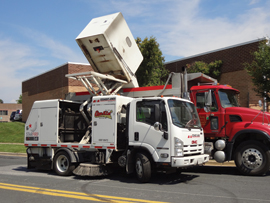
![albert1[1]](https://ymlp.com/https.php?id=purewatergazette.net/blog/wp-content/uploads/2013/06/albert11.jpg)
